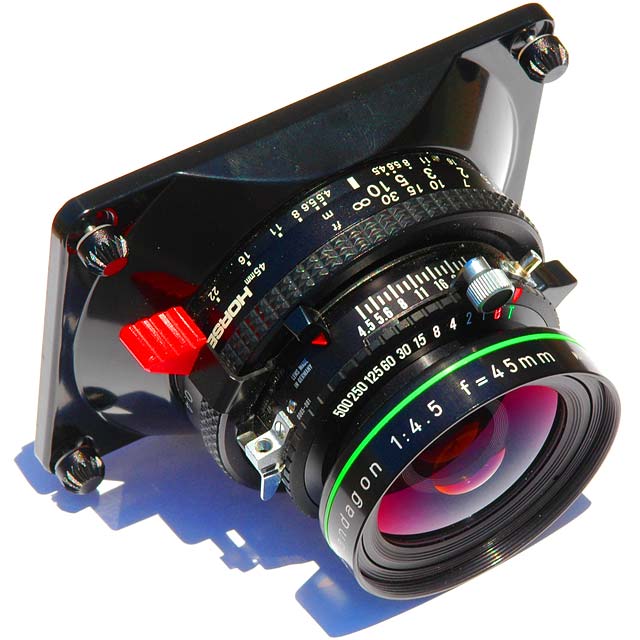
Home Search Gallery How-To Books Links Workshops About Contact
Rodenstock
45mm f/4.5 APO-Grandagon
for Horseman SW-612 and SW612

Rodenstock 45mm f/4.5 in mount for Horseman SW612 and SW612P.
Introduction This is an ultra wide-angle 110 degree large format lens in a helical focusing mount for the Horseman SW612 and SW612P panoramic camera systems. It covers 6 x 12 cm medium large format film, with a little shift to spare if you have the SW612P (shift) body. |
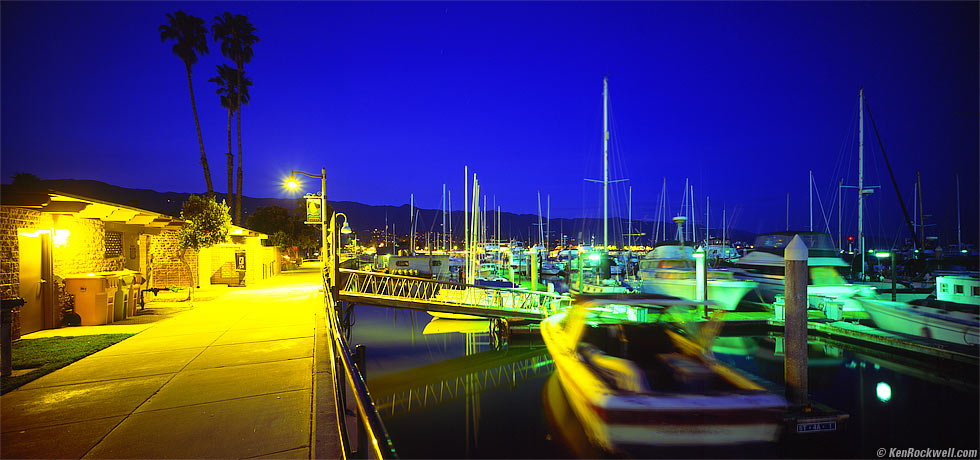
Harbor, Santa Barbara, California. (6x12cm Fuji Velvia, time-exposure shows boat motion.)
| It sold new for $2,800 in New York City here in 2006. As of 2008 I see a lower price, but in what looks like a very different mount, at that retail link to Adorama. I can't seem to find it at B&H other than with the whole camera system for $4,700. |
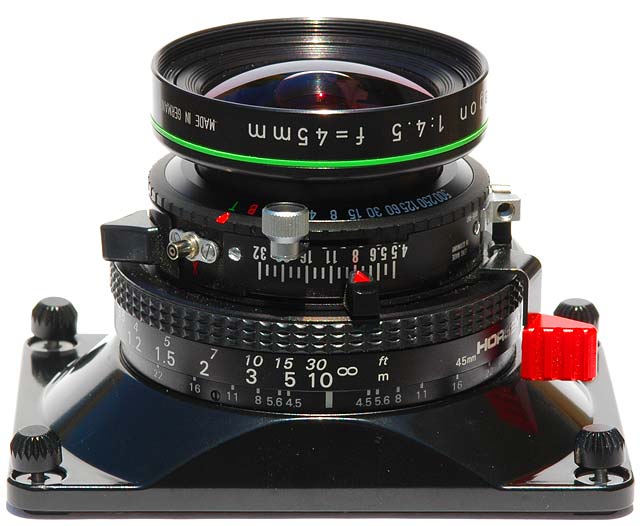
Rodenstock 45mm f/4.5 in mount for Horseman SW612 and SW612P.
Specifications Focal Length: 45mm Maximum Aperture: f/4.5. Optics: 8 elements in 4 groups. ED glass and Apochromatic correction. Expert multicoating. Diaphragm: 7 blade. Stops down to f/32. Filter Thread: 58mm, metal. Image Circle: 131 mm. Angle of View: 110 degrees. Actual Image size with Horseman 6x12 Back: 56.5 x 114.0 mm. Shutter: Copal #0: 1 - 1/500 plus Time and Bulb. Mount: Very special helical focusing mount for the Horseman SW612 and SW612P cameras. (more about the SW612 system here.) Close Focus: 15-3/4"" (0.4m). Weight: 18 oz. (515g). |
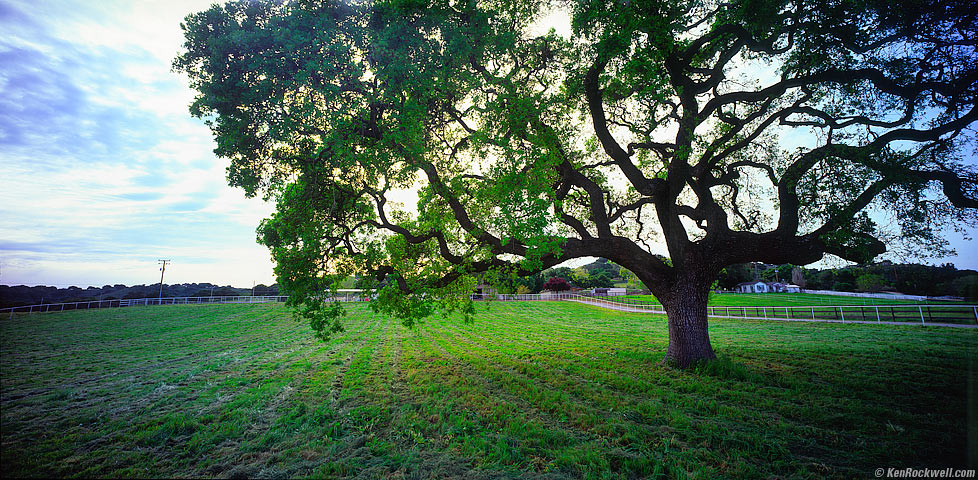
Oak, Santa Barbara County, California. (6x12cm Fuji Velvia, hand-held.)
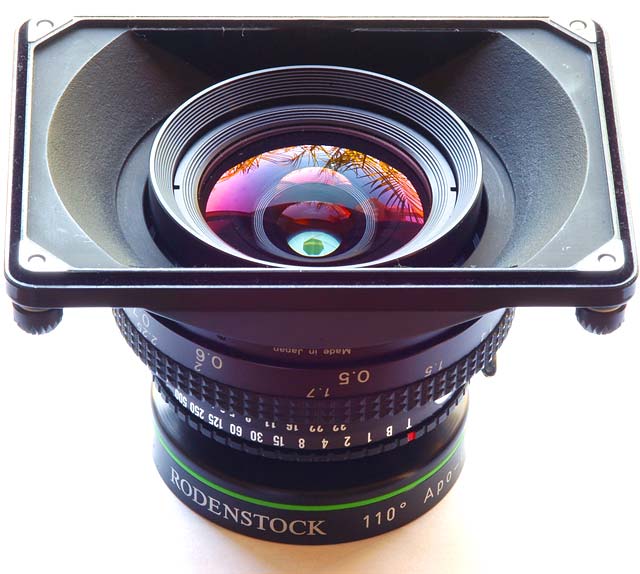
Rodenstock 45mm f/4.5 in mount for Horseman SW612 and SW612P.
35mm Equivalent Fields of View On 6x9 cm film (actually 56x72mm), this 45mm lens sees the same field of view as a 19.2mm lens sees on a 35mm film camera. This 45mm provides full shifts on 6x9, something no 19mm lens can do on the 35mm format. Vertical field of view on 6x12 cm is similar to a 19 mm lens on a 35 mm camera. Since 6x12 cm film is a wider rectangle than 35mm film, this 45mm lens sees the same horizontal field of view as a 14.5mm lens sees on a 35mm film camera.
|
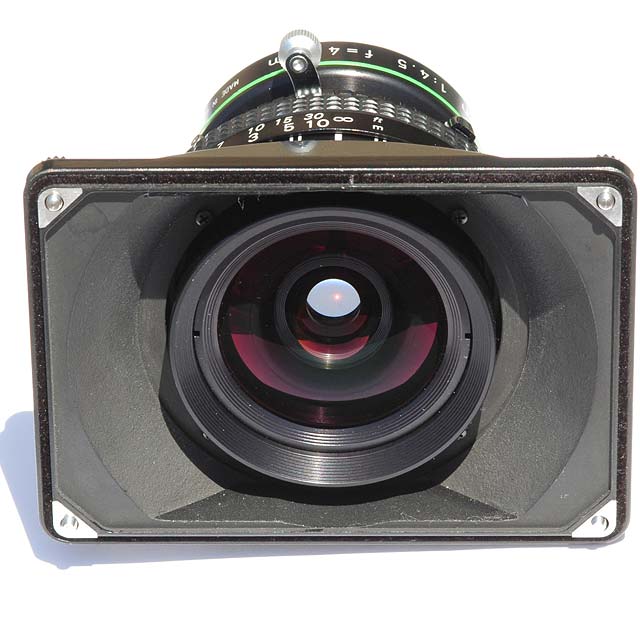
Rodenstock 45mm f/4.5 in mount for Horseman SW612 and SW612P.
Performance Performance, like most view camera lenses, is pretty much perfect for real photography. It's good enough to be used at the larger apertures hand-held, even for 6x12 cm. Like all lenses, the center of the image is the best, and everything gets weirder towards the sides. If you're only shooting 6x9 or 6x7cm, you'll never see any of the things I'm going to describe which happen towards the sides of 6x12 cm film. Coverage The Rodenstock 45mm is designed to cover 6x12 cm medium-format panoramic (actually 56x112mm) film with no movements. I can use the full shifts of my SW612P with the 6x9 cm back. On 6x12 cm I can get 6mm of vertical shift, only. This is better than specified: Rodenstock specifies no movements on 6x12, and the image size on my Horseman 6x12 back is slightly bigger than standard (56.5 x 114.0 mm). Falloff (darkened corners) As to be expected from all ultrawide view camera lenses, this Rodenstock 45mm has extreme falloff on the sides of 6 x 12 transparency film (Fuji Velvia). You can use a center filter to fix this if it bothers you. It never bothered me for real photography. If you're coming from using an SLR, this falloff may be a surprise for you. The good news is that even though ultrawide SLR lenses (retrofocus design) correct for falloff which these lenses can't, the simpler design of these view camera lenses lets this Rodenstock lens have better sharpness, smaller size and far better distortion than an SLR lens. You can use a center filter to eliminate the falloff of this lens, but no filter can improve the sharpness, physical size or distortion of an SLR lens. If you shoot brick walls, you'll want a center filter. For real photography, I can't see much of a difference with or without a center filter. All the center filter does is cost me two stops of light, which if I'm hand-holding, I don't have. If I'm on a tripod at night, I don't have the time to wait around for longer exposures. Be careful: if you're shooting with the sun at your back, the light on the subject at each side of a 6 x 12 cm film image will be at 45º angles. This will darken the sides naturally, which looks exactly like lens falloff to the uninitiated, but it's just nature. The two example shots at the top were made without a center filter. In both cases I composed to take advantage of the natural lens falloff. For the oak, I knew the falloff would dim the otherwise distracting sky to the left, and bring up the center of the tree for emphasis. For the shot of the harbor, I let the falloff bring down the brightly lit left side. The right side is dimmer, but mostly because it's further away from the light source. DistortionI see no distortion, even when deliberately looking for it. My Schneider 47mm f/5.6 Super Angulon XL has some pincushion when used on the SW612, but this Rodenstock 45mm doesn't. Peripheral Color Shifts Very few people notice this, but like almost all SLR and view camera lenses, the color balance gets cooler towards the edges of 6x12 cm. Why? Because lens coatings become less efficient at longer wavelengths (reds) as light hits the glass at steeper angles. Warm-color transmission gets poorer as one gets away from the center of the lens. This is unchanged with or without a center filter. The only lens I've seen any better than this is Nikon latest incredible 14-24mm, which uses exotic nano-particle coatings which change colors at the edges to compensate. This effect only concerns ultra-wide lenses. Normal, tele, and more reasonable wide lenses don't show this effect because the angles of incidence to the glass aren't as insane. Sharpness Unlike shooting digital or small-format (35mm and 6x6) film, lens sharpness is something that just doesn't matter when shooting large formats like 4x5" and 6x12 cm. This is because one usually is shooting at tiny apertures on a tripod, where diffraction is more significant, and the simple fact that large format lenses are much simpler non-retrofocus designs that are sharper than SLR lenses to begin with. Resolution is far more than needed for digital: at a reasonable 3,200 DPI, I get 14,400 x 7,200 pixel (100MP or 300MB) film scans. Rodenstock suggests not using it wider than f/11, but it works fine if you can tolerate more falloff and some haziness caused by coma. f/4.5: sharp in about a 60 mm image circle, softer outside of that. f/5.6: sharp in about a 60 mm image circle, softer outside of that. f/8: coma only on the brightest points at the far corners. f/11: sharp in about a 80 mm image circle, softer outside of that. Field seems curved, bringing closer objects in focus at the periphery. This is exactly as I like my fields to curve. |
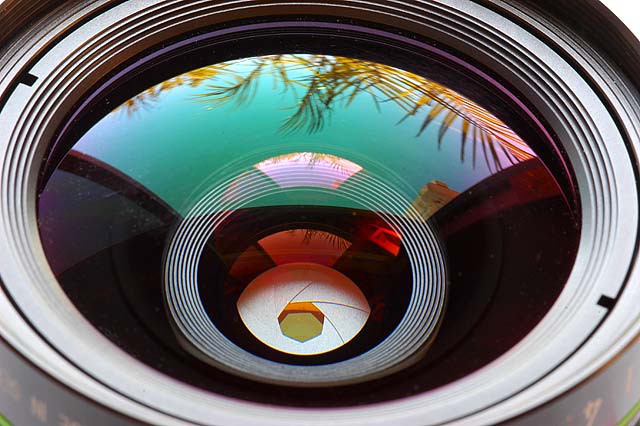
Front element
Recommendations If you want one, you know who you are. I liked this lens so much I went and and bought the even more expensive Schneider 47mm f/5.6 Super Angulon XL in order to give me the ability to use the full shift potential of my SW612P. If you have a regular SW612 (no shifts), don't bother with the Schneider, especially since I see just a little pincushion distortion with my Schneider, but never from this Rodenstock. The reason to splurge for the Schneider is for shifts on 6x12. |
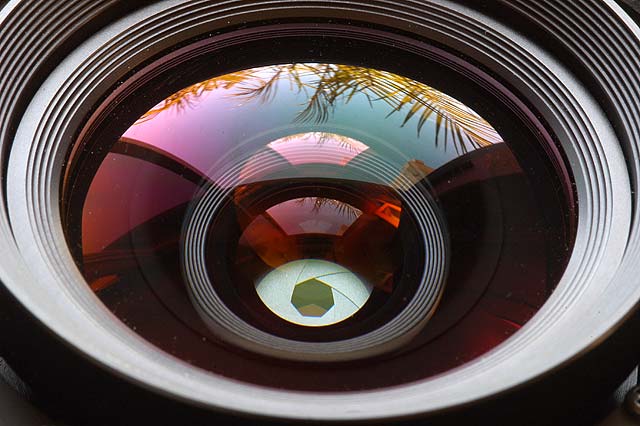
Rear Element
Home Search Gallery How-To Books Links Workshops About Contact